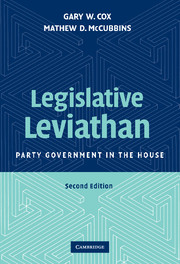Book contents
- Frontmatter
- Contents
- List of Figures
- List of Tables
- Acknowledgments
- Legislative Leviathan
- Introduction
- PART ONE THE AUTONOMY AND DISTINCTIVENESS OF COMMITTEES
- PART TWO A THEORY OF ORGANIZATION
- PART THREE PARTIES AS FLOOR-VOTING COALITIONS
- PART FOUR PARTIES AS PROCEDURAL COALITIONS
- PART FIVE PARTIES AS PROCEDURAL COALITIONS
- Conclusion
- Appendix 1 Uncompensated Seniority Violations, Eightieth through Hundredth Congresses
- Appendix 2 A Model of the Speaker's Scheduling Preferences
- Appendix 3 Unchallengeable and Challengeable Vetoes
- Appendix 4 The Scheduling Power
- Bibliography
- Author Index
- Subject Index
PART TWO - A THEORY OF ORGANIZATION
Published online by Cambridge University Press: 05 June 2012
- Frontmatter
- Contents
- List of Figures
- List of Tables
- Acknowledgments
- Legislative Leviathan
- Introduction
- PART ONE THE AUTONOMY AND DISTINCTIVENESS OF COMMITTEES
- PART TWO A THEORY OF ORGANIZATION
- PART THREE PARTIES AS FLOOR-VOTING COALITIONS
- PART FOUR PARTIES AS PROCEDURAL COALITIONS
- PART FIVE PARTIES AS PROCEDURAL COALITIONS
- Conclusion
- Appendix 1 Uncompensated Seniority Violations, Eightieth through Hundredth Congresses
- Appendix 2 A Model of the Speaker's Scheduling Preferences
- Appendix 3 Unchallengeable and Challengeable Vetoes
- Appendix 4 The Scheduling Power
- Bibliography
- Author Index
- Subject Index
Summary
In the previous part we scrutinized several of the key building blocks of the committee government model, concentrating on the notions that committees are autonomous and distinctive. Autonomy can mean many things; we focused on the extent to which the committee personnel process can reasonably be described as autonomous, concluding that it cannot. Distinctiveness also can mean many things; we focused on the geographical and ideological representativeness of House committees, concluding that most committees are representative most of the time.
In this part we shift gears from an examination of empirical details to a broad theoretical question: Why and how might a group of legally equal and often contentious legislators nonetheless create and maintain parties? The answer that we give to this fundamental question is similar in essential respects to the “theory of the firm” developed in the industrial organization literature in the 1970s and 1980s. But one need not be familiar with this literature to follow the argument. The basic ideas – which are also available in the Hobbesian theory of the state, the theory of political entrepreneurship, and elsewhere – boil down to this: parties are invented, structured, and restructured in order to solve a variety of collective dilemmas that legislators face. These “collective dilemmas” – situations in which the rational but unorganized action of group members may lead to an outcome that all consider worse than outcomes attainable by organized action – are inherent in the drive to be reelected in a mass electorate and in the process of passing legislation by majority rule.
- Type
- Chapter
- Information
- Legislative LeviathanParty Government in the House, pp. 77 - 78Publisher: Cambridge University PressPrint publication year: 2007



